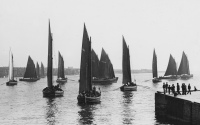Herring Home | Fishing for herring | Next
Expansion of the herring fishery: bigger and better boats
East Coast herring fishing expanded through the 19th century. There were more boats and more fishermen. Bigger, faster and safer boats were built with more, and better equipment. These advances meant that boats were able to fish further offshore and could go out in more demanding weather. They also held more fish.
By the 1870s boat length had increased to about 40 feet and by the turn of the century, the largest fishing boats were over 80 feet in length. In 1800 the average boat had a keel length of only around 25 feet. As boat length increased, other dimensions also became proportionately larger. Masts and sails increased in size with masts standing over 50 feet above the deck. The job of raising the mast, yard and sail by block and tackle became very heavy work. This was helped by the introduction of winches or capstans in the 1850s to assist in hauling the main rope. Hulls also became broader in beam and deeper in draught and this led to greater demand for piers and harbours.

These advances were all expensive. The price of boats, for example, rose from around £200 in the 1870s to £500 or more in the 1890s. To meet the higher costs, fishermen needed to make more use of their boats and equipment. They found new areas in which to fish, often further from home. They could also move to other fishing areas where fishing took place outside their local season, so extending the length of the fishing season. The fishermen might also fish for longer in their local grounds. Finally, the more advanced boats could search for shoals of fish, rather than waiting for them to appear..